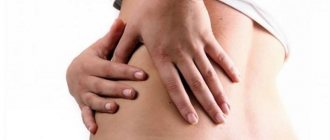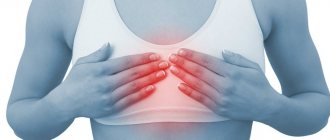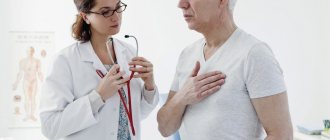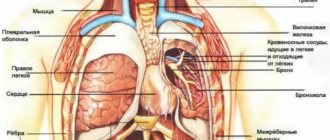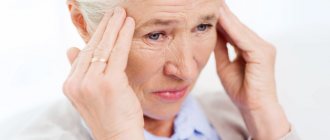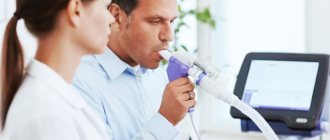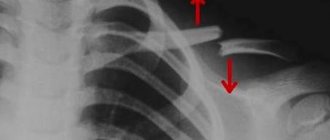Osteochondrosis of the thoracic spine
This disease is very common today.
People who have sedentary jobs are especially susceptible to it. With this pathology, the nerve endings extending from the spine are compressed, which causes pain under the left rib. It often radiates to the back, buttock, and even thigh; it can be encircling in nature, accompanied by numbness and tingling. The fact that the cause of pain is osteochondrosis may also be indicated by a decrease in the mobility of the thoracic region. “Shots” occur not only when inhaling, but also during movements and sudden turns of the body. In most cases, they overtake a person after being in an uncomfortable position for a long time. They often happen during sleep.
Why does it hurt in the left side under the ribs when inhaling?
Often, when inhaling, people experience pain under the ribs on the left; there can be many reasons. When such a problem arises, patients, as a rule, do not understand what to do, what can be done to cure it, and also which doctor to contact.
But if you know the main causes and symptoms, you can identify the approximate problem yourself. Further in the article we will talk about what pathological processes in the human body can cause pain in the form of colic, as well as what preventive and therapeutic measures will help avoid such discomfort.
Causes of stabbing pain
Pain that appears on the left when inhaling indicates the development of pathology. Patients need to concentrate and understand the nature of the manifestations, their intensity and time of occurrence. The main reasons include the problems that are presented in the table below.
| Aperture problems: | With prolonged exertion or due to injury, the diaphragm may become pinched or herniated. As a rule, this is the cause of pain under the ribs on the left; when inhaling, the pain becomes stronger as the load increases. The problem can be felt in front and behind. | Intercostal neuralgia: | If a pathological change occurs in the body as a result of the inflammatory process, then compression of the nerves that are located between the ribs begins. In this case, the pain is localized on the left side and is acute, intensifying with inhalation, with exertion or movement of the body. The problem will not allow the patient to breathe, move, or even sleep normally. Unpleasant sensations radiate to the back, and if treatment is not carried out, a constant aching pain begins. After several days of the disease, the patient may be immobilized, since even minimal movement leads to severe pain. | Acute appendicitis: | This problem can be easily distinguished from others by its place of origin and symptoms. In addition to spasms on the left side under the rib, the sensations move to the navel, and additionally, flatulence, gas, and bloating begin. If you empty the intestines, the problem disappears, but after a few hours it reappears. Inhaling and actively moving the sensations intensify. | Heart diseases: | Pain syndrome often indicates heart problems. The cause is a heart attack or ischemic heart disease. In this case, the pain will be dull, aching or stabbing. The discomfort becomes stronger when the patient inhales, the sensations radiate to the back, under the shoulder blade. Often there is shortness of breath, which is constant and does not subside even at rest. The pulse quickens, a feeling of heaviness under the rib and even a burning sensation appears. | Spleen diseases: | This organ is located closest to the body and during failures or other disorders the spleen becomes larger in size. Due to this factor, sharp and unpleasant pain appears.
| This disease is inflammation of the kidneys. As a rule, the pathology is accompanied by aching, sharp pain on the left. The symptoms radiate to the back, and against the backdrop of spasms, the head begins to ache and the body temperature increases. | Osteochondrosis: | A common problem, the disease is not very dangerous for people, but it brings a lot of inconvenience. The cause of the pathology is the loss of strength of the vertebral discs, they become less elastic, due to this the cartilage and spine are deformed. The nerves are compressed, causing discomfort in the left hypochondrium. Often the discomfort radiates to the back. | Gastritis: | The reason is poor diet, virus, stress. Mostly, pain begins to appear during exacerbations. Additionally, accompanying symptoms appear in the form of vomiting and nausea. The symptom is transmitted under the shoulder blade. | Stomach ulcer: | Discomfortable sensations arise as a result of intoxication of the body; vomiting and diarrhea can be caused. The causes are similar to those for gastritis. When you take a deep breath, the sensations intensify. Source: //pozheludku.ru/boli-v-zheludke/kolit-v-levom-boku-pod-rebrami-pri-vdohe.html |
Intercostal neuralgia
Intercostal neuralgia is another very common factor that causes pain under the ribs on the left. The latter is very similar to the heart, which can cause real panic. The reasons may be:
- osteochondrosis;
- unsuccessful rotation of the body;
- hypothermia;
- draft;
- cold;
- enlarged uterus (during pregnancy).
An attack of intercostal neuralgia is often accompanied by numbness of the upper extremities, muscle twitching, increased sweating, and pallor of the skin. The pain intensifies not only when breathing, but also when coughing, sneezing, yawning, turning the body, and can last from several hours to a couple of days. Often a person is forced to remain immobilized all this time, since every movement brings him pain.
Splenic rupture
This is an organ located in the hypochondrium on the left side. The spleen is a kind of storage facility for red blood cells. It is involved in immune processes and is involved in cleansing liquid connective tissue from harmful substances.
When the spleen ruptures, a stabbing pain occurs when inhaling on the left side under the ribs. The abdominal cavity is damaged and blood leaks into it. Against this background, the pain when inhaling on the left under the ribs on the side increases significantly. Over time, it covers the entire abdomen. It becomes extremely difficult for a person to swallow air.
In addition to pain when inhaling under the rib on the left, the following symptoms are observed:
- cyanosis of the skin in the area where the spleen is located;
- chills;
- nausea turning into vomiting;
- high body temperature;
- arterial hypotension.
If there are signs of organ rupture, you must immediately call an ambulance. But even with timely intervention by doctors, the spleen can be saved only in 1% of cases. Therefore, the main treatment for this condition is complete removal of the organ.
Heart diseases
Pain in the left hypochondrium may well be caused by heart diseases, such as ischemia, angina, cardiomyopathy and others. The most serious of them is myocardial infarction. Pain in this case is accompanied by both the development of the pathology and the condition preceding it.
Associated signs indicating a heart attack:
- dyspnea;
- chills;
- cold clammy sweat;
- nausea;
- vomit;
- diarrhea;
- sharp pallor of the face (even to the point of cyanosis) and puffiness;
- numbness of hands.
Pain on the left side can radiate to the shoulder blade, shoulder, or neck. It is sharp, burning (and not aching, as, for example, with colitis), accompanied by heaviness behind the sternum. If you have such symptoms, you should immediately call an ambulance, as this is a life-threatening condition.
Pathologies of the diaphragm
This is the main respiratory muscle, which conditionally separates the chest and abdominal cavity. As a rule, the cause of pain on the left under the ribs in front when inhaling is a diaphragmatic hernia, during the development of which the lower part of the stomach moves upward due to an increase in the lumen of the esophagus.
This pathological condition can occur against the background of:
- regular high-intensity physical activity;
- pregnancy;
- chronic constipation;
- excess body weight;
- pathologies of the gastrointestinal tract;
- respiratory diseases.
Diaphragmatic hernia is a serious illness, the danger of which is that over time the functioning of the digestive system, heart and lungs is increasingly disrupted.
Main symptoms of the disease:
- Aching pain on the left under the ribs when inhaling air. It is permanent.
- Frequent episodes of regurgitation (almost after every meal).
- Heartburn.
- Belching air.
- Difficulty swallowing food.
- Bloating.
- Cough.
- Tachycardia.
Treatment of pathology involves the use of surgical methods, during which the surgeon returns the stomach to its place and sutures the lumen of the esophagus. Conservative therapy in this case is ineffective. Medications only temporarily reduce the severity of symptoms.
Lung cancer
With cancer of the left lung, when the tumor grows into the pleura, pain appears in the chest. They usually appear at a late stage. The pain radiates to the neck, arm and stomach. It can be sharp and stabbing. Often has a girdling character.
This symptom is accompanied by others characteristic of lung cancer:
- This is primarily a cough.
- The patient suffers from lack of appetite and rapidly loses weight.
The signs of this pathology are in many ways similar to dry pleurisy. And pain in the left side when inhaling is one of the common symptoms. Pleurisy is often the first and only manifestation of tuberculosis, occurring at its initial stage. It is diagnosed when there are foci of disease in the lungs or lymph nodes.
Tuberculous pleurisy can be purulent. Accompanied by fever, increased sweating, shortness of breath, chills. A person suddenly loses weight.
Diseases of the respiratory system
Pain on the left side under the ribs in front when inhaling may indicate the development of pleurisy or pneumonia. In the first case, the pathological process affects the lungs, in the second - the serous membrane that surrounds them.
Pneumonia is an acute infectious disease. The clinical picture and severity of symptoms directly depend on the cause, gender and age of the patient.
General symptoms of pathology:
- Increased body temperature. The rise comes sharply.
- General signs of intoxication of the body (weakness, rapid onset of fatigue, headache).
- Dry cough. Appears in 3-5 days. Gradually it turns into a wet form, accompanied by sputum.
- Painful sensations in the chest area, aggravated by inhalation. They can radiate to the area of the left or right hypochondrium, and the pathological process can also be bilateral.
- Dyspnea.
Pleurisy is a disease that, as a rule, is not independent in nature, but accompanies a number of other pathologies of the respiratory system. The disease can have both a dry and exudative form.
The clinical picture of the disease directly depends on the underlying cause. Common symptoms include: pain in the left or right hypochondrium, worsening with inhalation; reflex painful cough; increased body temperature; chills; weakness.
Treatment of pathology consists of eliminating the underlying disease and reducing the severity of symptoms.
Stomach ulcer
With a perforated stomach ulcer, pain may also occur under the left rib in front. This symptom is preceded by signs characteristic of colitis (flatulence, bloating). Then the person is overtaken by pain, it is dagger-like and strong. Sometimes tolerable, and sometimes capable of causing loss of consciousness, it can shift slightly to the right.
Often pain occurs after eating. Accompanied by other symptoms: nausea, loss of appetite, vomiting, belching with an unpleasant aftertaste. If cutting, stabbing pain occurs and there is a history of a stomach ulcer, urgent hospitalization is necessary.
Gastritis
When there is periodic pain in the upper left side, gastritis can be suspected. Discomfort is also felt in the stomach. The pain is not acute - aching, radiating under the shoulder blade. It usually occurs after eating and then subsides. It often does not bring much discomfort to a person, so many do not attach importance to it for a long time. Meanwhile, the disease progresses.
Painful sensations with gastritis are accompanied by periodic nausea, heartburn, unpleasant belching, vomiting, problems with stool (constipation or diarrhea), weakness, and pale skin. When moving, turning the body, as well as taking a deep breath, the pain in the stomach area and above may intensify. Many manifestations are similar to signs of colitis, so gastritis is differentiated from this disease first of all.
Causes and types of pain under the left shoulder blade from behind from the back
The reasons for the development of this pathology are different, they have their own symptoms. Pain on the left side under the shoulder blade from the back is characterized by the following sensations:
- acute;
- dull;
- pulling;
- piercing;
- shooting.
Pain under the left shoulder blade from the back can be of the same type or alternating. There are times when one type of discomfort gives way to another, for example, stabbing turns into shooting. The pathology is caused by various injuries and their consequences, disorders of the musculoskeletal system:
- rib damage – discomfort is felt throughout the shoulder;
- osteoporosis, arthritis – affects the neck and shoulders in addition to the shoulder blade;
- Disc displacement – pain causes spinal canal stenosis;
- wear (aging) of the skeletal system - unpleasant sensations in the scapula area can occur when the bone structure changes in old age;
- bursitis - the formation of exudate due to inflammation of the periarticular bursa also causes pain;
- tear of the rotator cuff - sharp, acute pain in the area of the left shoulder blade from the back with the inability to rotate the arm indicates a violation of the shoulder muscles or tendons responsible for coordinating the shoulder joint;
- dislocation - discomfort in the left side of the back may be a consequence of dislocation of the collarbone or shoulder joint;
- nerve damage - pinching of the dorsal scapular nerve is also characterized by painful sensations in the back (under the left shoulder blade).
Referring back pain in the area of the shoulder blades on the left is considered a signal indicating the following pathologies:
- abscess pneumonia;
- acute inflammation of the bronchial mucosa;
- focal pneumonia;
- pulmonary pleurisy;
- stomach ulcer;
- esophageal spasm;
- pancreatitis;
- gastroreflux.
Heart disease may be another reason why a patient has back pain on the left side under the shoulder blade:
- heart attack;
- pericarditis;
- angina pectoris;
- mitral valve prolapse.
In addition, it causes discomfort and pain under the left shoulder blade from the back - increased muscle tone:
- poor posture;
- uncomfortable position while sleeping;
- neck muscle strain.
Only a visit to a specialist will help to correctly determine the causes of a burning sensation under the left shoulder blade from the back.
Diseases of the bronchopulmonary system
Pain above the left shoulder blade from the back can occur with problems with the lower respiratory tract (bronchi, lungs, pleura). The main cause of respiratory pathologies are considered to be diseases provoked by pathogenic viruses and bacteria:
- bronchitis;
- pneumonia;
- pleurisy.
New growths in the lungs or bronchi can also cause a burning sensation under the left shoulder blade from the back.
Pleurisy of the lungs
Increased pain under the left shoulder blade at the back when coughing, breathing or sneezing is characteristic of dry pleurisy. The process occurs with an increase in temperature (up to 38°C), a feeling of general weakness, sweating, headaches, as well as aching pain in the muscles and joints.
Pneumonia
If the left back hurts under the shoulder blade for a long time, this may be a sign of pneumonia. Its symptoms are similar to pleurisy and are often accompanied by the following signs:
- bloody clots in saliva;
- wet cough (less often dry);
- lack of oxygen;
- elevated body temperature (37.5°C – 37.9°C).
Gastrointestinal tract
One of the most common causes of scapular back pain is diseases of the digestive system, especially peptic ulcers and pancreatitis.
Pancreatitis
Back pain under the left shoulder blade, which is based on pancreatitis, is not observed so often. They usually occur in parallel with lower back pain and convulsive contractions. They appear unexpectedly in the area of the heart, chest, or back.
Peptic ulcer
When a peptic ulcer develops, a person experiences belching or heartburn. A significant proportion of patients (about 75%) feel relief after vomiting, which is caused by significant pain with preliminary nausea. Initially, discomfort is observed in the epistragal region, and then the pain can spread to the left side (nipple, sternum, back). Often, increased pain occurs after eating.
The cardiovascular system
Pain under the left shoulder blade from the back is not considered a sign characterizing a specific disease, but malfunctions in the cardiovascular system are considered one of the important factors. The main diseases characterized by these symptoms include: angina pectoris, myocardial infarction, aortic aneurysm, hypertensive crisis and pericarditis.
Angina pectoris
With angina pectoris, a person experiences acute left-sided subscapular pain from the back, to relieve which nitroglycerin is used. An attack of angina pectoris can be caused by physical exertion, psychophysical factors, hypothermia, overeating and drinking a significant amount of alcohol.
Myocardial infarction
The characteristic pain under the shoulder blade on the left back from the back can be caused by a complete lack of coronary blood supply to one of the areas of the myocardium due to blockage of the vessel. The causes of a heart attack are:
- atherosclerosis;
- thrombosis.
When a blood clot (plaque) breaks off, it enters the heart with the blood flow and, once in the small-diameter coronary arteries, they block the vessel and interrupt the delivery of blood to the tissues. With a lack of oxygen, the process of death of myocardial cells begins.
Symptoms of myocardial infarction include sharp and throbbing pain concentrated in the left side of the sternum. Distributed in the area:
- left hand;
- shoulder blades;
- lower jaw.
It is impossible to relieve pain during a heart attack with analgesics, and nitroglycerin can only slightly reduce pain.
Aortic aneurysm
In half of cases of thoracic aortic aneurysm, there are no signs of disease in the early stages. Symptoms depend on the location of the aneurysm, its size and the presence (absence) of dissection. In addition to pain in the scapula area from the back, the following complaints are possible:
- discomfort in the left side of the back, neck, lower jaw;
- chest pain;
- cough, hoarseness, difficulty breathing.
May be accompanied by signs of heart failure due to heart failure. Symptoms may occur unexpectedly and include sharp pain in the chest and left side of the back.
Hypertensive crisis
Contrary to popular belief, a hypertensive crisis is not characterized by any standard blood pressure numbers; they are purely individual. In addition to the sign that the patient has colitis under the left shoulder blade from the back, the symptoms of a hypertensive crisis include:
- headache in the back of the head;
- pulsation in temples;
- shortness of breath;
- nausea and vomiting;
- vision problems;
- skin redness;
- increase in diastolic blood pressure values above 110-120 mm Hg. Art.
When a hypertensive crisis occurs, the risk of complications from a number of systems and organs, the central nervous system, etc. increases.
Pericarditis
Patients may present with symptoms of inflammation (acute pericarditis) or signs of fluid collection (pleural effusion). They vary depending on the degree of inflammation and the volume of pericardial fluid. In acute pericarditis, pain occurs on the left side under the scapula from the back, in the chest, and sometimes shortness of breath is noted. The first manifestation may also be tamponade with the development of hypotension, shock or pulmonary edema.
Musculoskeletal system
Various destructive pathologies in the spine and bones can cause back pain under the left shoulder blade. In addition, these include: intercostal neuralgia, osteochondrosis and intervertebral hernia.
Intercostal neuralgia
Pain in the back in the area of the shoulder blades on the left with neuralgia has its own characteristics, for example, it intensifies during physical activity, and the pain point can be determined by palpation. Neuralgia pain is long-lasting and cannot be minimized with nitroglycerin.
Osteochondrosis
Osteochondrosis is often a common cause of pain under the shoulder blade on the left side of the back and is characterized by the following symptoms:
- muscle spasms, numbness;
- development of dizziness;
- the appearance of “goosebumps” (paresthesia);
- frequent headaches.
Intervertebral hernia
A herniation occurs when the annulus fibrosus surrounding the intervertebral disc ruptures, resulting in displacement of the disc core. Symptoms of a herniated disc depend on its location. The most important symptom of a herniated disc is pain in the left side of the back, which increases exponentially when moving or lifting heavy objects.
Psychosomatic diseases
One of the causes of pain under the left shoulder blade from the back can be considered psychosomatic diseases. Not every specialist will be able to recognize this disease and its true causes, since they often do not have special features. Different organ systems can have a direct relationship with the dynamics of the patient’s mental state:
- Gastrointestinal tract;
- vascular-cardiac system;
- nervous system;
- immunity.
Treatment of pain under the left shoulder blade from behind from the back in psychosomatic diseases occurs without the use of traditional therapy. In such cases, it is important to establish psychological motives and carry out treatment with a psychotherapeutic focus.
Pancreatic diseases
The pancreas is located on the left side, and with pathologies of this organ, pain in the hypochondrium often occurs. This is one of the most typical symptoms of pancreatitis. The pain is girdling in nature. It is unsharp, aching, and often quite strong. The intensity increases as you inhale. A person has to “fold” in half to alleviate the condition.
Pain usually occurs after a feast. Especially abundant and with the use of strong drinks. Inflammation of the pancreas is accompanied by nausea, vomiting with bile, and heartburn. The urine becomes dark, and the stool becomes abnormally light in color. During acute attacks, the temperature may rise significantly.
Osteochondrosis
Currently, this is the most common spinal disease. During its development, degenerative-dystrophic changes in bone and cartilage tissue occur. According to statistics, about 90% of the world's population suffers from osteochondrosis.
The main reasons for the development of the disease:
- improper formation of the spine during intrauterine development;
- hereditary predisposition;
- the natural aging process of the body;
- disturbance of phosphorus and calcium metabolism;
- unbalanced diet;
- inactive lifestyle or, on the contrary, high-intensity physical activity;
- vibrations that are long-lasting or regular (for example, when driving);
- excess body weight;
- smoking;
- various types of injuries;
- weakness of muscle tissue in the back;
- scoliosis;
- flat feet;
- infectious diseases;
- constantly being in a state of stress;
- living in unfavorable environmental conditions;
- wearing uncomfortable shoes, including high-heeled models;
- pregnancy.
If, when you inhale, there is a stabbing sensation in the left side under the ribs, this is considered a symptom of thoracic osteochondrosis. In addition, a person may experience a feeling of numbness in the area of the heart and stomach. Often the pain radiates to the left shoulder blade or shoulder. The patient also experiences rapid onset of fatigue even with minimal mental and physical exertion.
In most cases, the treatment regimen for osteochondrosis includes the following points: medication, physical therapy, physiotherapy, massage, traction, kinesiotaping, diet.
Pathologies of the spleen
Another organ located on the left is the spleen. It is closest to the surface of the body, so any abnormal processes occurring in it immediately make themselves felt. Problems with the spleen often occur after or during infectious diseases, since this organ is responsible for filtering blood from dead red blood cells. It greatly increases in size, fighting the virus, which explains the discomfort.
Sometimes the spleen is damaged by the ribs as a result of injury. It breaks. In such cases, pain appears not only when sighing or moving, but also on its own. It can be very strong, difficult to bear, and it radiates to the back.
Pathologies of the spleen are often accompanied by increased body temperature, inflammation of regional lymph nodes, headaches, and enlarged liver. When an organ ruptures, the skin in the navel area turns blue. If such symptoms are present, you should immediately seek medical help.
Acute pyelonephritis
If your left side hurts under the ribs when you inhale, this may indicate kidney pathology. The term “acute pyelonephritis” refers to an inflammatory process in which the pyelocaliceal system and intermediate tissue of the organ are involved.
The main reason for the development of the disease is the spread of infection to the kidneys from the lower urinary tract. This occurs in the presence of one or more provoking factors.
These include:
- intestinal dysbiosis;
- vaginal dysbiosis, an increase in its acidity;
- hormonal imbalance;
- frequent change of sexual partners (for women);
- increased intrarenal pressure;
- ureteral strictures;
- prostate adenoma or cancer;
- stones in the ducts through which urine is excreted from the body;
- hypothermia;
- diabetes;
- pregnancy;
- overwork;
- viral infections;
- hypovitaminosis.
If the left side of the organ is affected, the disease can be suspected if the following signs are present:
- The urge to urinate becomes more frequent. In this case, urine is not released.
- When inhaling, the left side hurts under the ribs, the unpleasant sensations radiate to the abdominal cavity.
- General health worsens.
- Body temperature rises.
- A feverish state appears.
- Sweating increases.
Gradually, the pain with a deep breath on the left (under the ribs) reaches its maximum peak. Its severity decreases somewhat as you exhale. Coughing, sneezing, any physical activity - all this increases the intensity of painful sensations so much that a person may lose consciousness.
The key to successful treatment is timely provision of medical care. The prognosis is considered favorable if the disease subsides while taking medications. According to statistics, in 30% of patients the disease becomes chronic. At the same time, the risk of developing pathologies that pose a threat to the patient’s life remains.
What to do if such pain occurs
When a person experiences pain in the left hypochondrium when inhaling, it is recommended not to waste time and contact a medical facility to determine its correct cause. The following doctors diagnose this condition:
- endocrinologist;
- cardiologist;
- gastroenterologist;
- gynecologist;
- surgeon.
Self-medication is strictly prohibited, because it will worsen the general condition and provoke the emergence of various complications. You need to know when to go to a medical facility. There are situations when pain cannot be ignored. An ambulance should be called in the following cases:
- aching pain that lasts for an hour;
- dull pain accompanied by coughing and vomiting (often with blood);
- stabbing pain that does not go away for more than half an hour and gets worse;
- sudden sharp pain.
So, we have looked at the most common situations in which pain occurs in the left hypochondrium when taking a deep breath. It can also occur with movement, coughing, sneezing, and even at rest. In most cases, the cause of pain is serious dysfunction of vital organs: heart, stomach, lungs, pancreas, spleen.
And sometimes we are talking about critical conditions when a person needs help urgently. Therefore, if there is pain in the left chest, you cannot endure it and wait for it to go away on its own. You need to contact a doctor as quickly as possible, establish the cause and eliminate it before unwanted complications and consequences appear.
Heart pathologies
In the human body, the diaphragm is closely connected with the central circulatory organ. That is why, in the presence of cardiac pathologies, the process of inhaling air can be accompanied by pronounced painful sensations.
As a rule, patients in this case are diagnosed with one of the forms of cardiomyopathy. The most dangerous is considered to be dilation, in which the heart becomes flabby and cannot fully perform its function. The causes of this pathology are unknown.
In addition to pain when breathing on the left under the ribs, patients complain of shortness of breath after performing any physical activity, dizziness, a constant feeling of weakness, swelling of the lower extremities, sleep disturbances, and frequent episodes of fainting.
For cardiomyopathy, symptomatic treatment is carried out. The prognosis for the presence of the disease is usually unfavorable. Until recently, the only option for patients was a donor organ transplant. But the difficulty is that the queue of patients is extremely impressive. However, finding a donor heart is almost impossible. Currently, the stem cell treatment method is used in practice.
